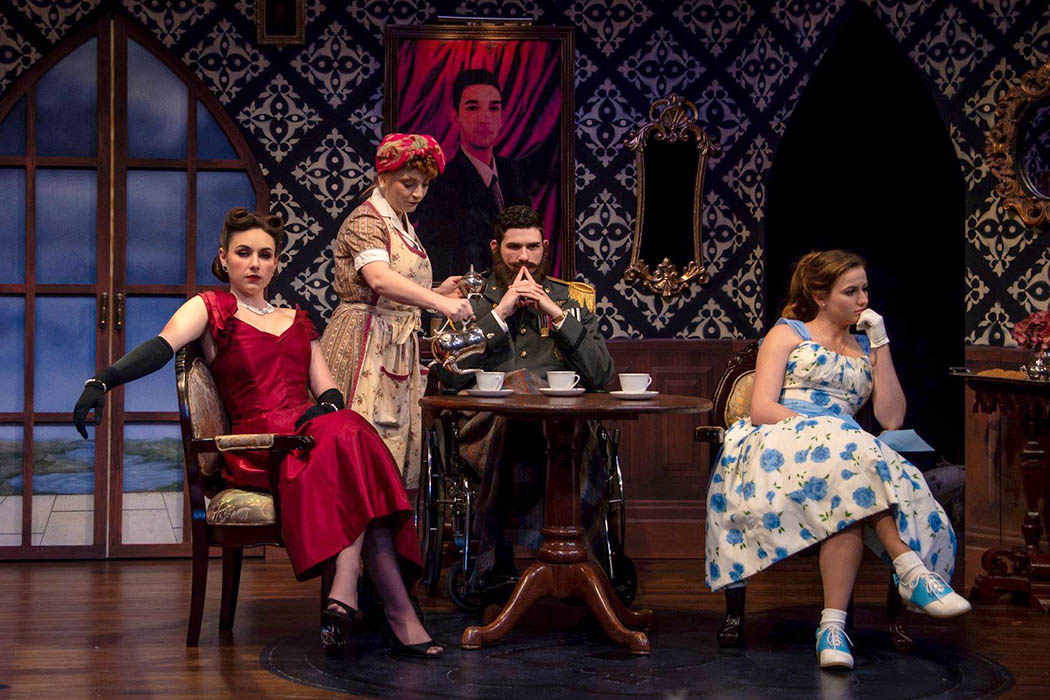I strongly insist on telling myself that the state of dramatic criticism has evolved noticeably since playwright Tom Stoppard, a former critic himself, wrote The Real Inspector Hound in the 1960s. Otherwise, his delicious parody of theatre critics, theatre criticism, and the entire genre of drawing-room murder mysteries, might lead one to an ironic, but comedic, reevaluation of the esteemed profession. As it is, though, I had no problem at all laughing along with the thoroughly amused and captivated opening night audience of The Real Inspector Hound in its current production in the Clarence Brown Theatre’s Lab Theatre. I believe I wore my critic’s disguise quite well, although I almost gave it away with more than a few unrestrained chortles.
Stoppard’s one-act parody starts as two critics, Birdboot and Moon, take their seats in a theatre having been assigned to review a third-rate murder mystery. Moon (Andrew Shipman), the second-string critic for his publication, finds himself, as the perennial stand-in, covering the play for the strangely absent lead critic, Higgs. Moon is wracked by bitter resentment of Higgs and his position, eaten alive by an unhealthy, if pompous, jealousy always set off when he is asked: “Where’s Higgs?” Birdboot (Jordan Gatton-Bumpus), on the other hand, uses his position for womanizing purposes, his targets being the actresses in the plays he reviews, plying them with gratuitous flattery in print, hoping for the appropriate compensation.
Both critics are ethically compromised and have no problem writing commentary before having seen the subject matter. Moon offers his sample: “The play, if we can call it that, and I think on balance we can, aligns itself uncompromisingly on the side of life.” The pair have both perfected a facade of normalcy—a facade that persists only as long as they follow the unwritten rule of never breaking the “fourth wall” of the theatre and allowing themselves to become involved.
Director Terry Silver-Alford has placed the two critics off to the side, audience right, watching the drawing-room whodunit unfold, a murder mystery naturally complete with a manor house on the moors, a madman on the loose, and an odd assortment of characters. The manor house belongs to the elegant Lady Cynthia Muldoon (Emily Helton), still pining for her husband who mysteriously disappeared 10 years ago. Two house guests, Felicity Cunningham (Callie Bacon) and Simon Gascoyne (Nicholas Johnson), have some kind of recent history of the red-herring kind. Also living in the house is Magnus (Justin Von Stein), a supposed half-brother of Lady Muldoon’s lost husband, now suspiciously confined to a wheelchair and in an even more suspicious fake beard. Naturally, when the Inspector Hound—real or otherwise—shows up (Tucker Comes), he is costumed in the mandatory deerstalker and tweed. And, of course, no murder mystery is complete without a butler or housekeeper, in this case the latter, the deliciously quirky Mrs. Drudge (Crystal-Marie Alberson).
Silver-Alford has drawn his excellent cast entirely from the ranks of CBT’s undergraduate theatre majors—a fact that speaks to the depth of talent in the Theatre department organization. Parodying bad theatre is notoriously difficult in knowing just how far one can go. As a result, director and cast have excelled in not only knowing where that point is, but also in capturing the essence of the mystery genre, tongue firmly planted in cheek. An example of this is Alberson’s Mrs. Drudge who virtually radiates comedic details and laughingly ridiculous exposition, her presence on stage magnetically drawing one’s attention to her by means of a wealth of subtle gestures and a squeaky, but controlled, voice. Similarly, Helton’s Lady Muldoon is in firm control of her stylish entrances and romantic body language, and seems a natural in parodying such behavior without breaking a smile. One scene of tea being served by Mrs. Drudge and another of cards being played by Felicity, Magnus, and Cynthia, was not only great comedy writing by Stoppard, but also great comedy acting. And, after seeing the production, I think all will agree that the actor portraying Higgs, Madison Castle, has now paid his dues.
As per the CBT norm, the production values are high. Scenic designer Carrie Ferrelli has created the quintessential drawing-room look, complete with theatrically-cheesy double doors and suggestions of a theatre’s wings and backstage. I do wonder at the decision to put the two critics off to the side, as one in the middle of the seating area in the Lab Theatre space can easily miss a line or gesture while focused on the opposite area. Fulfilling the tongue-in-cheek look of murder mystery parody were costume designer Margo Birdwhistell and lighting designer Collin Hall. Ominous radio announcements and “mystery music” was the province of Brandon Evans’ sound effects.
Stoppard has certainly nailed a number of human weaknesses in The Real Inspector Hound, as well as delivering a very intriguing lesson on forgetting the line between reality and theatrical fantasy. Perhaps the most satisfying aspects of this production, though, are the individual performances by the cast that highlight the best of CBT undergrad talent. In that, there is no mystery.







